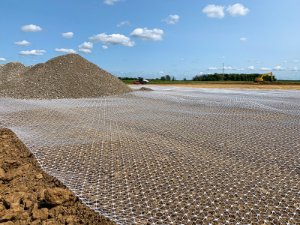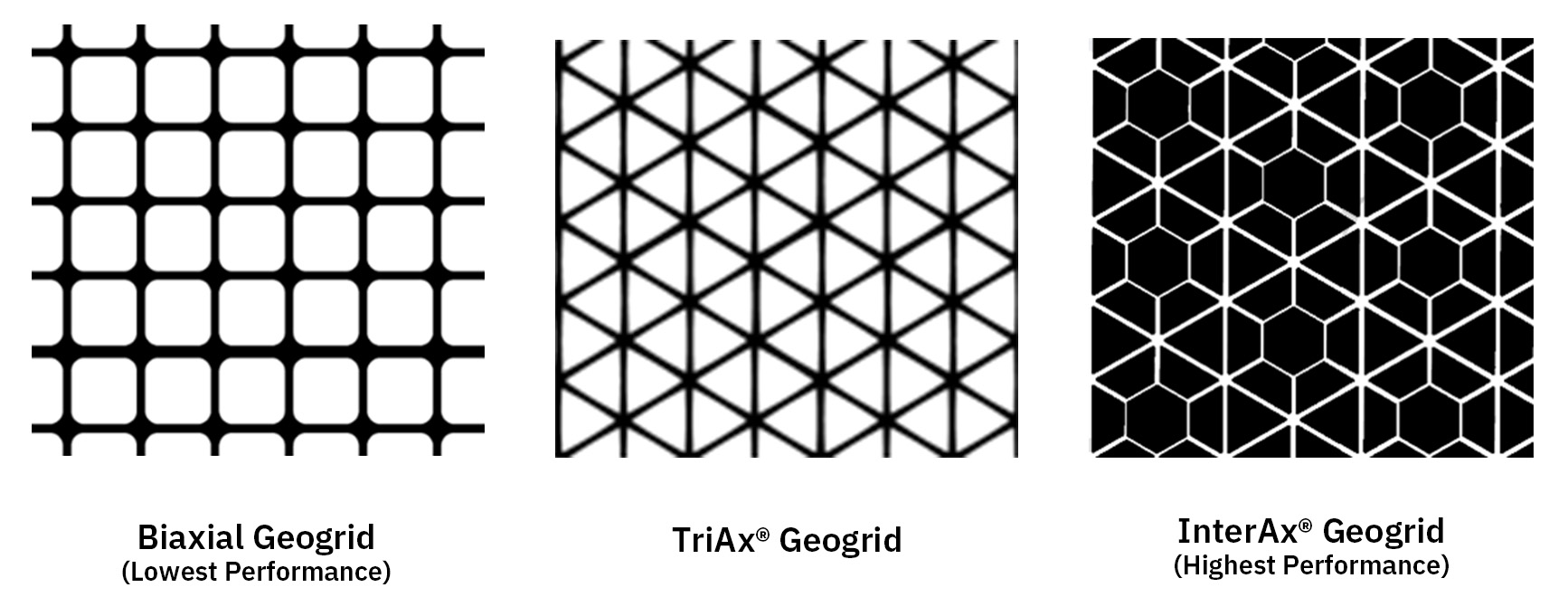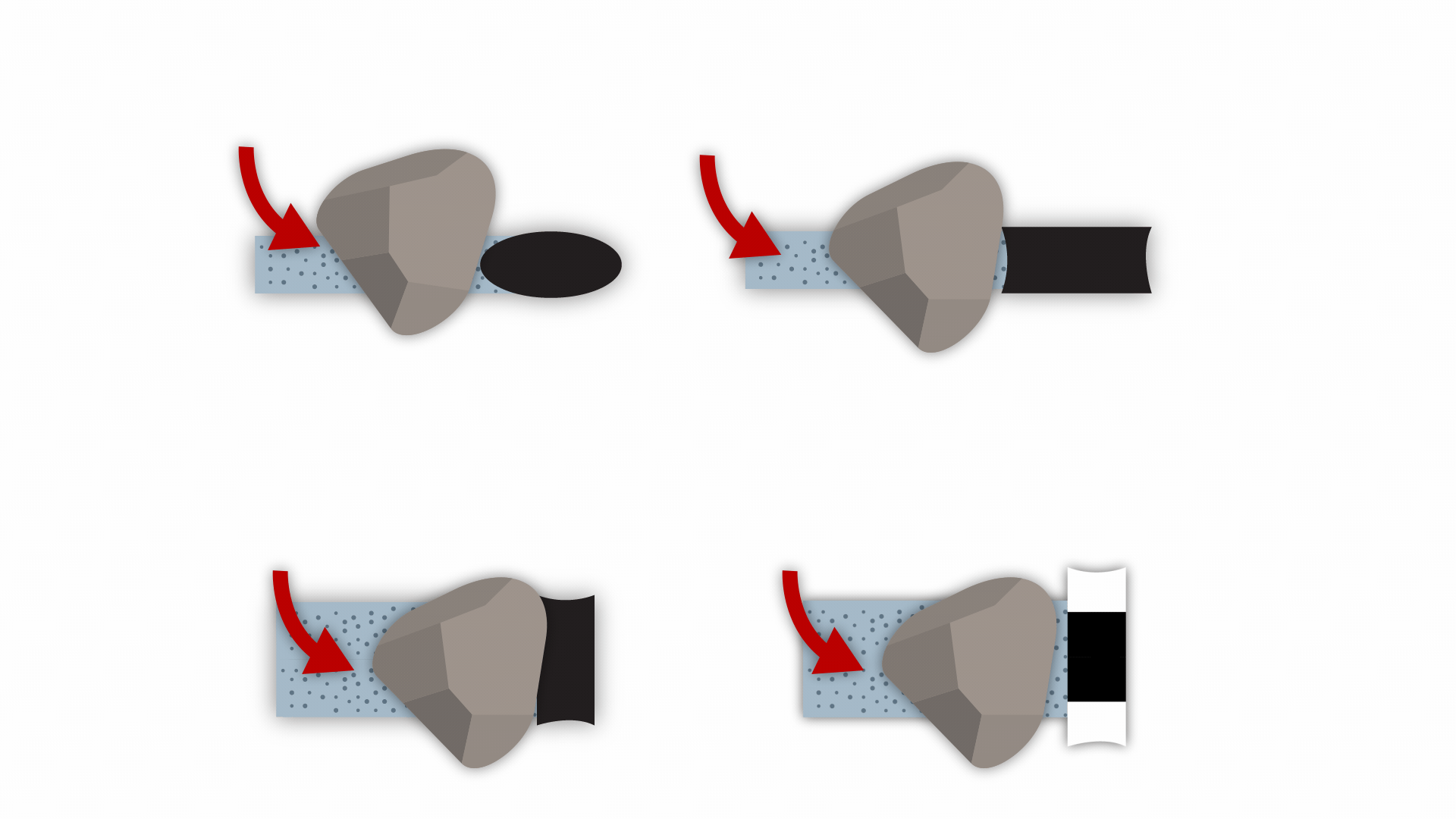Comparing Performance of InterAx®, TriAx® and BX Geogrids
by Bryan Gee, P.E., on September 06, 2023
 Geogrids first came on the scene in the early 1980s when Tensar introduced “extruded, punched and drawn” (“Tensar Process”) biaxial (BX) and uniaxial geogrids. Over time, these products have become widely accepted with proven success in a variety of civil and geotechnical applications requiring soil stabilization and reinforcement. The triaxial form was developed and introduced in the late 2000s as an improvement to the biaxial form, particularly for civil and geotechnical engineering applications where the applied loads are not limited to one or two directions (for example, pavements, haul roads, working platforms and general soil stabilization). In 2021, after decades of performance testing and product development, InterAx geogrids were introduced. InterAx is currently the most advanced geogrid on the market for trafficked surfaces. Its advanced materials science and revolutionary geometry maximize performance in stabilization applications.
Geogrids first came on the scene in the early 1980s when Tensar introduced “extruded, punched and drawn” (“Tensar Process”) biaxial (BX) and uniaxial geogrids. Over time, these products have become widely accepted with proven success in a variety of civil and geotechnical applications requiring soil stabilization and reinforcement. The triaxial form was developed and introduced in the late 2000s as an improvement to the biaxial form, particularly for civil and geotechnical engineering applications where the applied loads are not limited to one or two directions (for example, pavements, haul roads, working platforms and general soil stabilization). In 2021, after decades of performance testing and product development, InterAx geogrids were introduced. InterAx is currently the most advanced geogrid on the market for trafficked surfaces. Its advanced materials science and revolutionary geometry maximize performance in stabilization applications.

 Each type of geogrid is a unique and distinct engineering material with its own in-application performance capabilities. The obvious differences in geometry are significant among biaxial, triaxial, and InterAx geogrids. Each type of geogrid interacts uniquely with the aggregate that is placed and compacted to complete the mechanically stabilized layer, or MSL. This means that one type of geogrid should not be substituted for another without fully redesigning the application. Further, the mechanisms that create aggregate confinement in roadbed applications are very complex, and no two geogrids are the same. While biaxial, triaxial, and InterAx geogrids can all be used across many of the same applications, there are impacts on the other materials (i.e., aggregate, asphalt) involved in the application. For example, a haul road over soft ground can be designed with biaxial, triaxial, or InterAx geogrid (provided the product used has undergone appropriate performance validation testing). It’s important to remember – if the same level of performance is necessary, there will be different thicknesses of aggregate material required for each product. A lower performing BX geogrid may cost less but the additional aggregate requirement could quickly negate any geogrid cost savings compared to the high performing InterAx geogrid.
Each type of geogrid is a unique and distinct engineering material with its own in-application performance capabilities. The obvious differences in geometry are significant among biaxial, triaxial, and InterAx geogrids. Each type of geogrid interacts uniquely with the aggregate that is placed and compacted to complete the mechanically stabilized layer, or MSL. This means that one type of geogrid should not be substituted for another without fully redesigning the application. Further, the mechanisms that create aggregate confinement in roadbed applications are very complex, and no two geogrids are the same. While biaxial, triaxial, and InterAx geogrids can all be used across many of the same applications, there are impacts on the other materials (i.e., aggregate, asphalt) involved in the application. For example, a haul road over soft ground can be designed with biaxial, triaxial, or InterAx geogrid (provided the product used has undergone appropriate performance validation testing). It’s important to remember – if the same level of performance is necessary, there will be different thicknesses of aggregate material required for each product. A lower performing BX geogrid may cost less but the additional aggregate requirement could quickly negate any geogrid cost savings compared to the high performing InterAx geogrid.
Caution - Looks Can Be Deceiving
Even products that appear to be very similar may not perform the same. For example, Tensar has performed rolling wheel traffic testing on a Tensar biaxial geogrid and another non-Tensar biaxial geogrid of equal tensile strength; this testing showed the two products do not perform the same. As a result, each product must stand on its own data. Attempts to apply property data from one product to other “similar” products introduces the risk of non-performance. Further, and despite much research and effort, there are no proven correlations between the physical properties of geogrids and performance in roadbed and stabilization applications. To assure performance of geogrids in these applications, designs must be based on performance validation data for the specific geogrid product under consideration.
Substitution Considerations:
If you are considering substituting one geogrid for another, keep the following in mind:
- Conduct a full design review.
- Confirm the alternative product has undergone the appropriate performance and validation testing.
- If the substitution is acceptable, confirm that a different level of performance, or a different design (e.g., a thicker or thinner aggregate layer) meets budgets and construction schedules.
Want a more in-depth look at comparing geogrids? Check out our webinar and earn professional development credit.
It’s important to have all of the necessary information before substituting a geogrid in a project. Contact your local Tensar rep for a complimentary project review to ensure you don’t make a costly mistake.
Comparing Geogrids
There are dozens of geogrids and other geosynthetic products on the market. How do you know which is right for your project's needs? When it comes to roadway construction, the keys are proper design and testing to validate performance.




